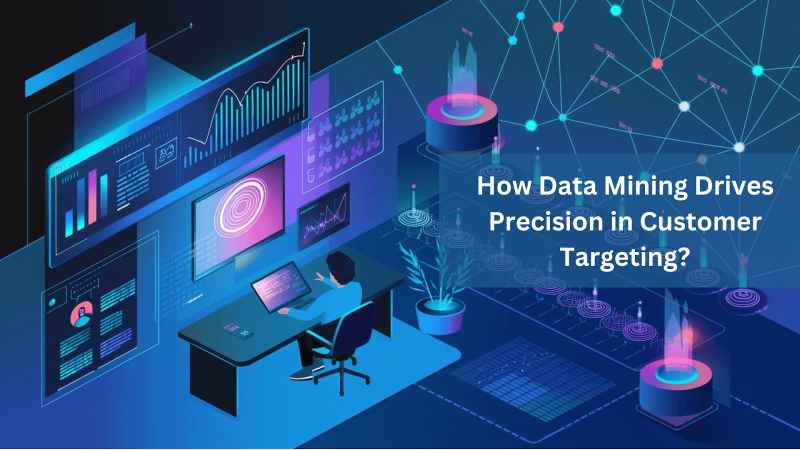How Can Data Analytics Boost Business Growth?

The growth is achieved when you have a data analytics-driven plan, which is very much realistic. None can be better to consider as an example than Amazon.com, Inc., which is a leading e-Commerce company. If you look into its growth rate, it’s over USD187 billion. In the first half of the current year, which is 2023, its revenue was USD134.383 billion. This is obviously a big jump of a 10.85% year-over-year.
Overall, it is data analytics that is significantly making a massive difference in this growth rate. Otherwise, there are hundreds of online shopping portals, but are way behind this leading giant of e-Commerce.
Do you know the reasons? Certainly, these causes can enable any business to grow up and achieve overwhelming growth rate.
Data Analytics Leading Exponential Growth
Customer Insights
Analyzing customers’ data can be a hectic task. Thankfully, we are living in the digital world wherein businesses have their online presence, which can be tracked or monitored through Google Analytics. However, tools like Ahrefs and SEMrush are also there that make it way easier when you are likely to know your web visitors’ intent, their likelihood, or preferences. In all, these details can be accessible in no time, which digital marketers and strategists study and come up with recommendations and personalized offerings accordingly. The data-driven initiates an excellent customer experience, which builds loyalty.
Decision-Making
Having insights is indeed an asset to make informed decisions. Businesses hire data entry experts at a reasonable price to collect data for analysis, but don’t rely on gut feeling and intuition. For informed decisions, they rely on analyzing archival and real-time streaming datasets. This practice informs them about the ins and outs of the brand’s products or services. It can let the strategist make corresponding marketing strategies. Later on, the business owner can align resources accordingly. Overall, data analytics is crucial in coming out with valuable strategies.
Market Segmentation
The market data can be split on the basis of demographic, geographic, and behavioural datasets. It simply means that one can discover the insight of the whole market. This understanding can let you devise customized marketing campaigns. It’s like which type of advertising can help in reaching out to a target audience, or which advertising channel has an easy reach to target customers. Once discovered these things, various organizations and entrepreneurs can think of ideas that can appreciate their return on investment on marketing campaigns.
Product and Service Optimization
Product and service optimization refers to the process of breathing new life into a product or service so that its worth can be improved to existing users and attract new users. The product or service manager optimizes it during the initial phase.
This optimization can happen when you have the previous details of your product/service. It can be like the data showing its growth rate year by year, supply & demand based details, and more like them. This information helps the company to discover patterns or models, which is like a piece of cake when you have access to artificial intelligence (AI) or business intelligence tools. The collected details can help in finding bottlenecks or gaps, which can be fixed to revive offerings, improve product quality, and innovate.
Data analytics can reveal patterns and trends related to product performance. Companies can use this information to refine their offerings, improve product quality, and identify opportunities for innovation.
Cost Reduction
Cost reduction is a common concern for all businesses or organizations. Getting deep into analytics can highlight the areas that need attentiveness within operations.
Let’s say an e-Commerce company is facing losses because of lots of lost packages. To reimburse, the company has to come forward and pay out that amount, which is certainly a kind of loss to revenue. The managed records of inventory, logistics, and supply chain can let you interact with upsides and downsides of these areas via analytics. Likewise, any business can determine the areas where it suffers from inefficiencies and wastage of resources. Once determined, the losses can be reversed, which results in cost-saving and profitability.
Also Read: 5 Differences Between Business Intelligence and Data Analytics
Risk Management
Risks are the real threats across various industries. These threats can be mitigated effectively if you thoroughly study data related to concerns. You can filter streaming data in real time to tap potential risks. With the help of business intelligence (BI) tools, discovering suspicious activities, cybersecurity threats, market fluctuations, & operational vulnerabilities is no big deal.
Once you have foreseen the risks in financial records, payment history, back office operations, you can anticipate glitches in the respective domains. You can identify faults, find risks, and foresee shifts in market demand, customer behaviour, operational efficiency, creditworthiness, or whatever you are involved in.
Simply put, getting deep into insights can let you interact with bottlenecks or the root causes that are causing operational failures and losses. If it’s related to compliance, regulatory requirements can be met timely without compromising on key metrics.
Competitive Advantage
Competitive advantage is all about winning more customer through better and inexpensive products or services. This can never be possible unless you have data of pricing, marketing changes, trends, and customer intent of your competitors. You need to find their reactions to market changes, which actually help in providing more enhanced customer experience.
If you consider the example, Walmart always excels when it’s about a cost leadership strategy. You can find its products always low in price because of economies of scale. On the other hand, the electronic giant – Apple comes up with supreme quality. It banks on its brand value.
This kind of cutting edge can be evolved by deeply understanding what your competitors are doing and offering. And for sure, their market performance data can help you in developing a unique selling proposition.
Predictive Analytics
Predictive analytics is all about anticipating what is likely to happen using historical data. For thinking about the future strategy, you need historical data. The tools like RapidMiners, Tableau, etc. can make it way automatic to anticipate anything that is concerned with your goals. Simply put, these tools can introduce you to trends, pricing models, customer interest, purchasing patterns, inventory status, and more like these details that are likely to occur.
You may be in the retail, insurance, or even in entertainment domain. This kind of analytics can help you to discover the realistic ways to hook up customers and continue to engage them for a long time.
Predictive analytics uses historical data to forecast future trends. This can be invaluable for inventory management, demand forecasting, and financial planning.
Also Read: 5 Ways to Improve Data Analytics for Business Strategies
Personalized Marketing
Personalized marketing is a powerful marketing strategy, which can significantly scale up sales. It actually involves customizing marketing efforts in accordance with customers’ preferences, behaviours, pain points, and needs.
For online business owners, leveraging Google Analytics tool can help in gaining profound insights into all details that are connected with the subject. This overview is sufficient to integrate with targeted and relevant marketing campaigns, or emailing campaigns. Being personalized marketing, it resonated with individual needs of customers. It makes individual customers feel special and respected, which automatically builds a connection with the brand.
The in-depth study of customers behaviour and purchase history can let businesses discover their requirements and preferences. Corresponding to their likelihood, these commercial entities offer personalized offerings & assistance. Moreover, it enables merchants to deliver highly targeted offers and overwhelmingly promote as per individual tastes. This practice increases conversions while exponentially reducing the wastage of money, which might be spent on broad or random campaigns. Possibly, that expenditure may not resonate with specific customers.
So, its aggression and utility can be proven through high conversion rate and customer loyalty. They feel being privileged and valued, which can inspire them to spread positive things. It may invite word-of-mouth referrals.
Operational Efficiency
Operational efficiency represents how well an entity performs or delivers by using its resources. It’s actually the ratio between the revenue generated or sale gained and the resources required. Typically, it is about measuring the gaps to reduce bottlenecks and streamline back-office operations in lower costs.
If your operations and complementary resources are properly streamlined and optimized, it directly impacts your savings. To achieve this condition, you need operations’ details of a specific time period. Get insights into these details, which can help in identifying patterns and gaining understanding of your back-office operations.
This data analytics driven intelligence can help entrepreneurs to foresee trends and customer preferences accurately. Accordingly, the owners can brainstorm how to optimize inventory and resources. Also, this insight guides to ensure that the products or inputs are readily available without running out of stock. As a result, meeting customer demands, which is connected with revenue, would be satisfying.
If you consider another aspect, which is related to bottlenecks and imperfections, data analytics can show how easy it is to implement targeted improvements. It can help you with defining pricing strategies, getting better in marketing campaigns, or even improving sales. Simply put, data analytics can guide you to create a more agile and responsive business model that can help you to sustain your demand in the market.
In the context of customer experience and management, the very same analytics can let you personalize your customers’ approach and you become able to foresee what your customers need. This intelligence makes it effortless to build stronger customer relationships and simultaneously, increase sales and word-of-mouth referrals.
Innovation and Product Development
When it comes to innovation and introducing new products, data analytics can be considered crucial. When you get deep into consumer behaviour, market trends, and emerging patterns, insights would indicate gaps in the market. Even, you can tap the likelihood of customers and undiscovered opportunities.
This intelligence is sufficient to foresee future trends. Moreover, you can proactively make decisions regarding what to come up with for customers in the market that will be high in demand. Additionally, data-driven insights will enrich you with the idea to streamline the product development process, minimize risks, and optimize resources.
For a new product idea, nothing can be better than customer feedback. They carry customers’ pain point that need healing and likelihood, as what they expect from a product/service. These all details can trigger innovation, which enhances the efficacy of product development strategies.
Also Read: Python vs SQL: Which is Better for Data Analytics?
Customer Retention
The increased attrition rate is actually a big concern for any organization that is struggling with it. After all, it can put a big question mark over the company culture, efficiency, and other aspects. So, you cannot skip measuring it.
Certainly, data analytics can help you combat this problem by providing valuable insights into customer behaviour, preferences, and trends. Through the analysis of historical data, especially feedback, can guide businesses to identify patterns and understand customer expectations. On that basis, prediction can be made, which helps in anticipating customer needs. Accordingly, companies can increase proactive engagement via personalized offerings, support, and content.
The insights can also make it crystal clear how to leverage them to create targeted marketing campaigns, personalized promotions, and loyalty programs that resonate with individual preferences. This not only helps in taking the customer experience to the next level, but also builds or enhances brand loyalty. Additionally, this insight reveals at-risk customers, which enable them to introduce effective and realistic retention strategies before issues escalate.
Here, you cannot ignore customer feedback, which can let you analyse sentiments. You can access them through social media monitoring so that it can further contribute to customer retention. This knowledge discovery can let you continuously refine strategies and create a customer-centric approach. This is how you can build lasting relationships and ensuring customer satisfaction and loyalty over the long term.
Also Read: Benefits of Big Data for a Successful Business
Performance Monitoring
Any kind of monitoring is related to discovering key performance indicators (KPIs) as how they performed and if they met objectives. It enables organizations to assess and enhance their efficiency of the back office operations and productivity. These days, some very effective tools are available, which can help in real-time monitoring. Their comprehensive understanding in real-time reveals crucial aspects, such as employee productivity, customer interactions, and operational processes. Tools can define them through visual patterns. The identification of patterns, trends, and outliers can help organizations to make informed decisions, as how to optimize performance. It can also help with discover what is going to happen, which can be potential issues. So, you can timely introduce proactive interventions.
Moreover, this intelligence can facilitate benchmarking against industry standards. This way, businesses can set realistic goals and track progress. As for stakeholders also, the visualization of complex data through dashboards and reports help in gaining actionable insights for improving consistently. All in all, data analytics can transform raw data into actionable intelligence, enabling organizations to monitor, measure operational performance, and elevate their performance effectively.
Conclusion
In essence, it won’t be wrong to state that data analysis is expanding the horizon of decision making and improving businesses.






